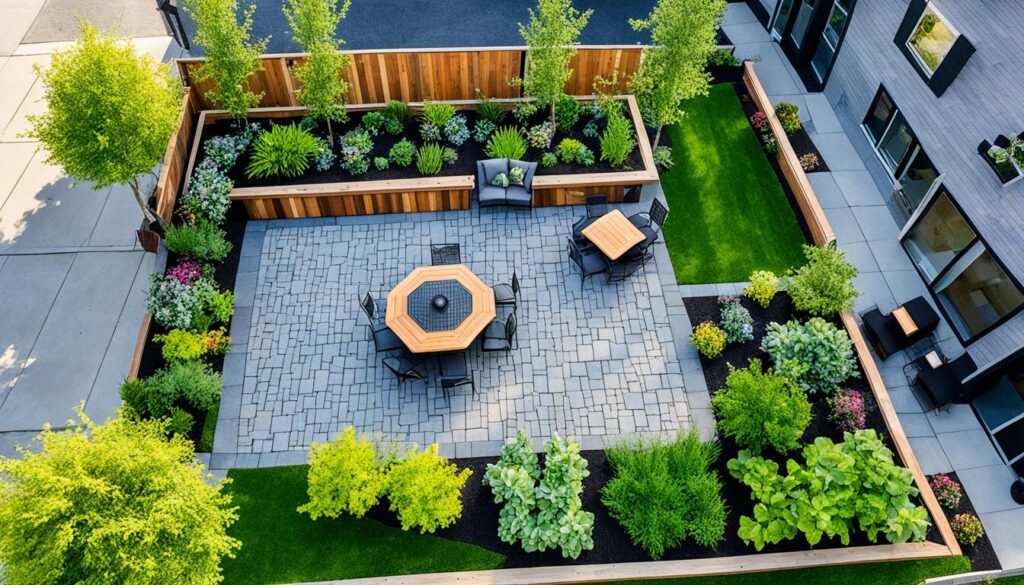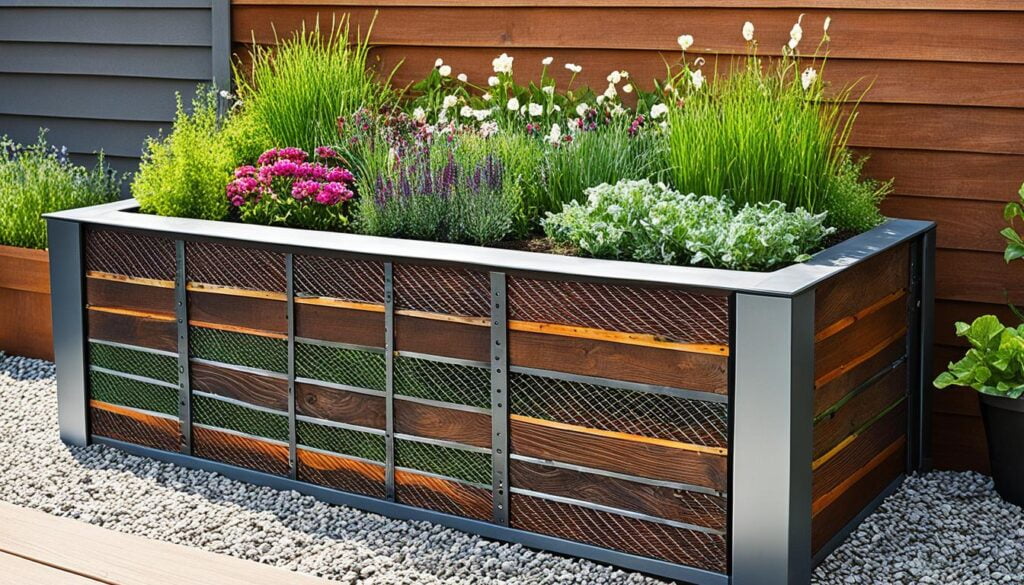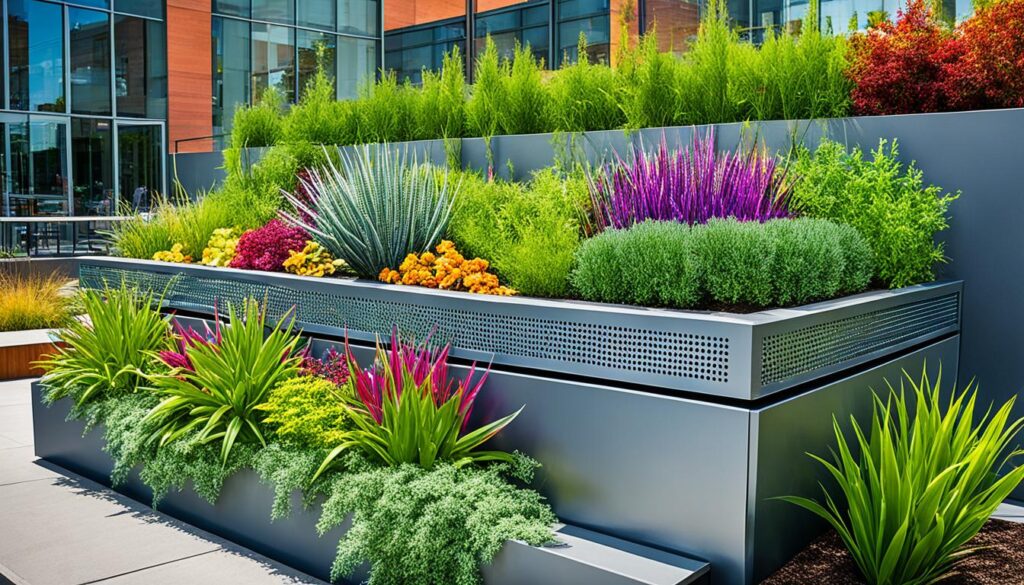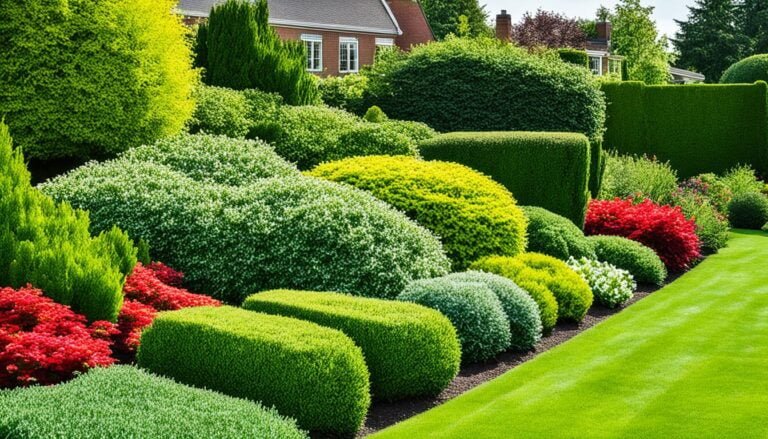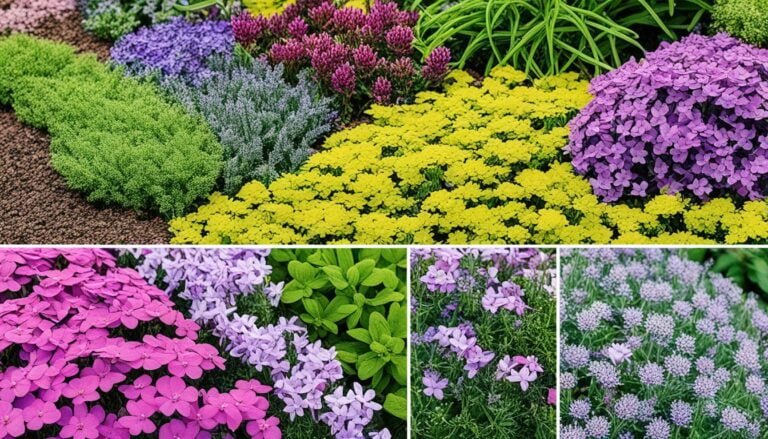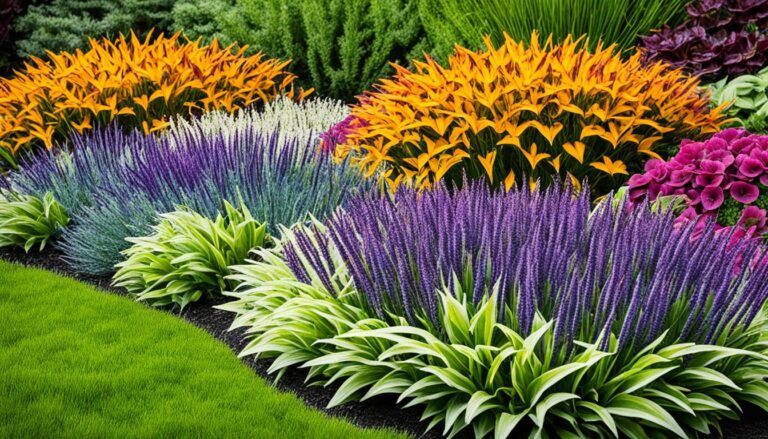Garden box designs Garden beds are important for growing plants and flowers. They make outdoor spaces look good and work better. You can use unique designs like DIY boxes and easily movable beds to make your space more interesting. When picking materials, choose untreated cedar wood instead of treated wood. This will keep your plants safe and make your garden box last longer.
In 2020 and 2021, the author made garden beds at home. They used 12 cedar 1×4 boards and 4 cedar 2×4 boards. The bed was 2′ x 4′ and 33″ tall. To fill it, they needed about 8 bags of soil. They also advised adding chicken wire and fabric inside to help the plants grow and keep pests away.
Try creative garden bed ideas like vertical or raised beds. They save space and make your outdoor area more interesting. You can grow many types of plants in these beds, like tomatoes and herbs. For tips on making your own raised garden bed, visit this guide.
Key Takeaways
- Unique garden box designs enhance both aesthetic appeal and functionality of outdoor spaces.
- Using untreated cedar wood ensures plant safety and longevity of the garden beds.
- The recommended dimensions for a raised garden bed are 2′ x 4′ with a height of 33″.
- Approximately 8 bags of gardening soil are needed to fill the raised garden bed.
- Lining the garden bed with chicken wire and landscape fabric or hardware cloth is suggested.
Why Choosing the Right Garden Box Design is Crucial
The right garden box design is key in outdoor spaces. They make everything look better and grow healthier plants. It’s vital to pick garden boxes that look good with your area.
Improved Aesthetics
A good-looking garden box can make your yard beautiful. Materials like wood, metal, or composite are great for this. Choose popular options like redwood and cedar for their long-lasting and pest-resistant features. It’s also nice to arrange your garden elements in threes or fives for a balanced look.
Functionality and Ease of Maintenance
Garden boxes make gardening easier and more fun. Raised beds have good soil that drains well and keep bugs and weeds away. They’re easy to take care of and work well in small spaces. For the best results, make sure beds are at least eight inches deep, but twelve inches is better for some plants.
Optimal Plant Health
The health of your plants depends on your garden box. Raised beds help by improving the soil and drainage. It’s key to put your beds where they get 6-8 hours of sun every day. Beds also keep the soil from getting too packed or dirty, especially when it rains. Choosing cedar or redwood that’s not treated is best for your plants’ health.
| Material | Benefits | Drawbacks |
|---|---|---|
| Wood (Redwood/Cedar) | Rot-Resistant, Pest-Resistant, Aesthetic Appeal | Higher Cost |
| Metal | Modern/Industrial Look, Long-Lasting | Can Overheat Plants |
| Composite | Maintenance-Free, Warp-Free | Less Natural Look |
| Recycled Materials | Eco-Friendly, Cost-Effective | Varies Greatly in Quality and Durability |
Assessing Your Outdoor Space
Before picking the right garden bed, it’s key to study your garden’s space. Different gardens need different things. You have to consider size and layout to choose raised beds or planters well.
Understanding Space and Layout
Good planning can make your garden work harder. A 4×8 raised bed is perfect for small gardens. You can plant lots together like vegetables and herbs by using the square foot method.
In these beds, you can grow a lot of food. For example, you can make sure you have fresh veggies all season by planting at different times. Remember to add compost regularly to keep the soil rich. Arrange your plants to meet your family’s tastes and needs.
Sunlight Patterns and Soil Quality
Knowing how much sun your garden gets is crucial. Most vegetables need a lot of sun. But, some prefer less light. Make sure you know your garden’s light conditions well.
Checking the soil is also very important. The type of soil affects what you can grow. Raised beds are good for bad soil because they improve drainage. Use tips like saving space by planting compact plants and adding flowers for beauty and to help your garden grow well.
| Factors | Considerations |
|---|---|
| Space Assessment | Garden dimensions, raised bed size, intensive planting |
| Sunlight Exposure | Full sun requirements, partial shade adaptation |
| Soil Quality | Drainage improvement, nutrient replenishment with compost |
| Planting Techniques | Square foot gardening, succession planting, layout examples |
For more tips, check out this resource on layout planning and garden strategies.
Creative Garden Box Designs for Small Spaces
Garden lovers short on space can still pursue their green dreams. Creative garden box designs help make the most of tiny outdoor spots. They use vertical and compact raised beds to grow lots in little areas.
Vertical Garden Beds
Vertical gardening is great if you have a small space. It uses vertical surfaces, letting you plant up rather than out. This method is good for herbs, leafy greens, and flowers, making small areas lush and productive.
Compact Raised Garden Beds
Compact raised beds are perfect for small gardens. They give better control over soil and drainage, making the plants healthier. You’ll also spend less time on weeding and other maintenance.
They’re also cost-effective to build. Making four fir beds cost about $225, while a vinyl one was $1200. Using untreated cedar stops chemicals getting into the soil.
Raised beds also make weeding easier. You only need to weed once about six weeks after planting. Good raised beds are open at the bottom for deeper root growth and to help good bugs. Adding quality soil, compost, and organic mix keeps the beds healthy for plants.
You can make raised beds from materials like bricks, stones, wood, cinder blocks, or galvanized tubs on a budget. VEGO beds are a durable, chemical-free option that can last over 20 years. They make small space gardening easy and fun.
For more details on affordable options for DIY garden beds, check out this resource.
Innovative Materials for Garden Box Designs
The materials for your garden box can make it stronger and look better. Wood, like cedar, is a top pick because it fights rot, is safe, and lasts a long time. Cedar garden beds are a smart and safe choice for any garden.
Wood and Cedar Options
In 2020 and 2021, many gardeners put in cedar garden beds. These often measure 2′ by 4′ and stand at 33″ tall. It takes around 12 pieces of 8′ cedar 1×4 and 4 pieces of 8′ cedar 2×4 for this.
They chose cedar because it resists rot, making the garden beds live longer. A roll of 2′ wide chicken wire and landscaping felt also join the party. They help the plants grow better.
Staples hold the chicken wire below, and the inside is covered with the fabric. This combo allows plants like tomatoes and carrots to flourish. Around 8 bags of soil are needed to fill the bed deep enough for these plants.
Recycled and Upcycled Materials
Some are going green with their garden materials. They’re picking recycled and upcycled items like old pallets and barrels. These choices make gardens look special while cutting down on waste.
Old stuff like pallets and chairs can make your garden unique. It’s not just about style. It’s about being kind to our planet too.
All these choices are bringing creative, sustainable, and pretty garden boxes to life. It mixes new, old, and recycled stuff. This makes gardening good for our earth and our eyes.
Garden Box Designs for Urban Gardens
Designing an urban garden is all about using space wisely and making it lush. Garden boxes, especially modular and elevated designs, let city folks grow greenery on rooftops, patios, and balconies.
Rooftop Gardens
Rooftop garden boxes turn unused space into green paradises. They are made to handle the wind and sun up high. Raised beds, made with heat-absorbing wood or insulation, are key for growing plants well.
Plants on roofs need at least 6 to 8 hours of sun daily. The square foot gardening method and successive planting work well here. After one crop, like lettuce, grow root veggies in the same spot.
Patio and Balcony Gardens
Patio gardens are great for small outdoor spaces. You can use raised beds or vertical planters for greenery. Balconies benefit from rail planters or corner-fitting modular designs.
Raised bed gardens lead to more harvest and less weeding. Adding compost keeps the soil healthy. Flowers like alyssum and marigolds help fight bugs.
Think about shade and container quality for your patio or balcony garden. Lightweight, durable planters are best. These designs make gardening possible in urban spots big and small.
Maximizing Functionality in Your Garden Boxes
To make your garden boxes work better, it’s key to add features that help plants thrive and make caring for them easier. With the right additions, your garden spaces will blossom with activity and rewards.
Incorporating Trellises and Climbing Frames
Trellises and climbing frames are important for garden boxes as they promote plants to climb. This includes crops like cucumbers, squash, and beans. They help save space and are especially great for raised beds and small gardens. These features make sure your plants get enough sunlight and fresh air.
By using trellises and frames, you can use your garden’s space smarter.
Installing Irrigation Systems
Adding an irrigation system is crucial for plant care. It makes sure your plants get the water they need, with less work from you. Systems like drip irrigation and soaker hoses are great for raised beds. They water plants at their roots, wasting less water.
This means your plants grow better and give you more fruits and veggies.
Adding these features to your garden beds will make them more productive and easy to maintain. Whether it’s trellises, frames for plants, or advanced watering systems, caring for your garden will be simpler. With these upgrades, your plants will be healthier and more vibrant.
Raised Garden Beds: Benefits and Best Practices
Raised garden beds are loved by many for good reasons. They offer lots of benefits and smart raised bed gardening tips. The writer, with more than ten years of experience, shares reasons why this way of gardening is a winner. Learning how to plant efficiently in these beds is key to getting the most out of them. Check out this guide on raised bed planting for expert advice.
Advantages of Raised Garden Beds
There’s more to raised garden beds than meets the eye. They tackle a lot of the issues gardeners face every day. With heights from 8 inches to 30 inches, they ensure your soil is top-notch and that water drains well. For those plants that stay close to the ground, higher beds up to 36 inches are perfect.
Beds that are about 15 inches tall are the best. They make planting and looking after your garden easier and ensure you won’t hurt your back.
- Improved Soil Quality: You can pick the perfect soil mix for your plants in raised beds.
- Better Drainage: With raised beds, you avoid drowning your plants because water drains well.
- Weed Management: Less space for weeds to grow makes it easier to keep them under control.
Best Practices for Raised Gardens
Using the right best practices makes your plants thrive in raised garden beds. Always start with filling the beds to the top. Then, add compost every year or so. Make beds 2.5 to 4 feet wide for the best planting space and easy care. Before you start planting, set up a good watering system, like drip irrigation, to keep your plants healthy.
| Raised Bed Heights | Benefits |
|---|---|
| 8 inches to 30 inches | Improved drainage, better soil control |
| Up to 36 inches | Ideal for low-growing plants |
The author suggests using treated lumber for building without worry. This wood is safe since 2003 because it uses copper instead of harmful arsenic. With raised beds, you can plant closer together because it’s easier to reach them, saving space.
Keep perennial herbs away from annual plants to avoid overcrowding. Following these tips ensures your raised garden beds support many types of plants beautifully.
DIY Garden Box Projects
Starting DIY garden boxes is a fun way to make something unique. It’s also cheaper than buying ready ones. The price of materials can change, like the high cost of lumber because of Covid-19. DIY helps you adjust and save money. For $225, you can make four garden beds. This is much cheaper than a $1,200 vinyl bed.
Simple DIY Garden Box Ideas
Beginners in DIY can start with easy-to-build planters. One great option is raised garden beds made of fir boards. For each bed, you need two 2×12 fir boards that are 8 feet long and one 2×12 fir board that is 10 feet long. This way, you get strong garden boxes. Using cedar wood that hasn’t been treated is also smart. It doesn’t rot easily and won’t release harmful chemicals.
Advanced DIY Planter Designs
Those who are more experienced might want to try making VEGO beds. VEGO beds last more than 20 years and don’t leak any harmful chemicals. It’s good to use steel fasteners to make them stronger and stop the wood from splitting. You can also make these beds any size you want, like 2 by 4 feet inside and 33 inches tall. Adding a shelf at the bottom for support and chicken wire trellises for climbing plants makes these planters even better.
DIY garden boxes let you match your garden space and needs. You can choose from many different materials and sizes. Adding special features can make your gardening much better and organized.


